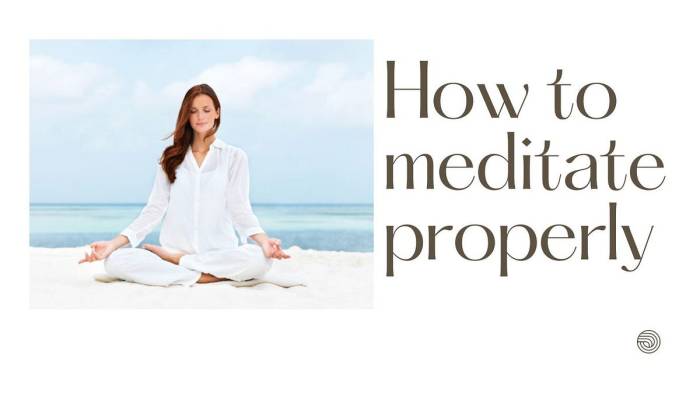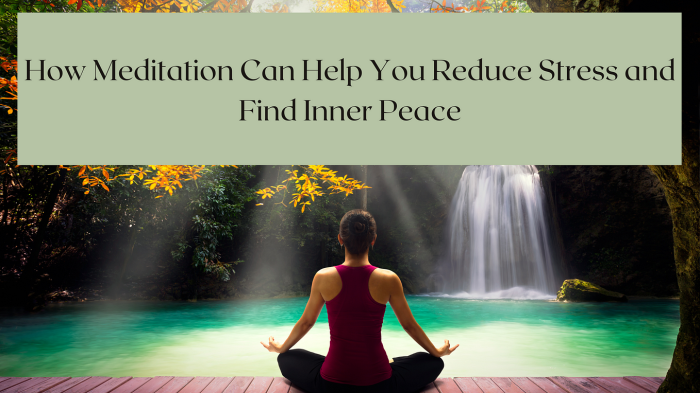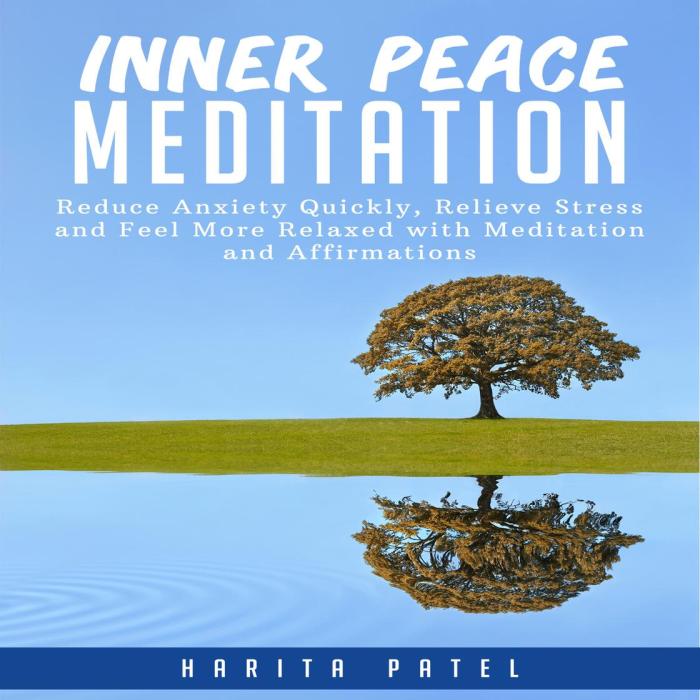How to Meditate for Creating Inner Peace in Times of Crisis sets the stage for finding tranquility amidst chaos, offering a path to serenity through mindfulness and relaxation techniques.
Exploring the essence of inner peace and the power of meditation, this guide delves into practical strategies to cultivate a calm and centered mind.
Introduction to Meditation for Inner Peace: How To Meditate For Creating Inner Peace In Times Of Crisis
![]()
Meditation is a practice that involves focusing the mind and eliminating distractions to achieve a state of clarity and calmness. During times of crisis, such as the current global pandemic, the benefits of meditation become even more apparent. By incorporating meditation into our daily routine, we can cultivate inner peace and resilience in the face of uncertainty and stress.
Benefits of Meditation During Times of Crisis
- Meditation helps reduce anxiety and stress levels, allowing us to navigate challenging situations with a clearer mind.
- Regular meditation practice can improve our ability to cope with uncertainty and adversity, promoting emotional well-being.
- By calming the mind and focusing on the present moment, meditation can enhance our overall sense of inner peace and contentment.
How Meditation Creates Inner Peace
- Through meditation, we learn to observe our thoughts and emotions without judgment, fostering a sense of self-awareness and acceptance.
- By practicing mindfulness and deep breathing techniques, meditation helps us stay grounded and centered amidst chaos and turmoil.
- Connecting with our inner selves through meditation allows us to tap into a source of strength and tranquility that transcends external circumstances.
Understanding Inner Peace

Inner peace refers to a state of calmness, tranquility, and harmony within oneself. It involves finding a sense of balance and emotional stability amidst external challenges and turmoil.
When it comes to deepening your connection to yourself, meditation plays a crucial role. By practicing mindfulness and self-reflection, you can truly understand your thoughts and emotions. One effective technique is to focus on your breath and let go of any distractions. For more tips on How to Meditate for Deepening Your Connection to Yourself, check out this insightful guide: How to Meditate for Deepening Your Connection to Yourself.
Importance of Inner Peace in Times of Crisis
During times of crisis, such as a global pandemic or personal challenges, inner peace plays a crucial role in helping individuals navigate through difficult circumstances. It provides a sense of grounding and clarity, allowing one to approach problems with a calm and rational mindset.
Visualization is a powerful tool that can enhance your meditation practice. By creating mental images and focusing on specific goals, you can amplify the benefits of meditation. Techniques such as guided imagery and positive affirmations can help you manifest your desires. Explore more about How to Meditate with Visualization: 8 Key Techniques for a deeper understanding: How to Meditate with Visualization: 8 Key Techniques.
- Inner peace acts as a shield against stress and anxiety, helping to reduce the impact of external factors on mental well-being.
- It fosters resilience and emotional strength, enabling individuals to cope with adversity more effectively.
- Inner peace promotes self-awareness and mindfulness, leading to better decision-making and problem-solving skills.
Positive Impact of Inner Peace on Mental Well-being
“In the midst of movement and chaos, keep stillness inside of you.”
Deepak Chopra
- Inner peace can reduce symptoms of depression and anxiety, improving overall mental health.
- It enhances emotional intelligence and empathy towards oneself and others, fostering healthier relationships.
- Practicing mindfulness and cultivating inner peace can lead to increased focus, productivity, and creativity.
Techniques for Meditating

Meditation is a powerful tool for cultivating inner peace, and there are various techniques that can help you achieve this state of calm and clarity. One popular method is mindfulness meditation, which involves focusing your attention on the present moment without judgment. This practice can help you become more aware of your thoughts and emotions, leading to a greater sense of inner peace.
Releasing fear and negative emotions through meditation is essential for emotional well-being. By acknowledging and letting go of these feelings, you can cultivate inner peace and positivity. Techniques like loving-kindness meditation and body scan can help you overcome fear and anxiety. Dive deeper into How to Meditate for Releasing Fear and Negative Emotions to learn more: How to Meditate for Releasing Fear and Negative Emotions.
Mindfulness Meditation
Mindfulness meditation is a practice that involves paying attention to the present moment with openness and curiosity. To practice mindfulness meditation for inner peace, follow these steps:
- Find a quiet and comfortable place to sit or lie down.
- Close your eyes and take a few deep breaths to help relax your body and mind.
- Focus your attention on your breath, noticing the sensation of each inhale and exhale.
- When thoughts or distractions arise, simply acknowledge them without judgment and gently guide your focus back to your breath.
- Continue this practice for a few minutes or as long as you feel comfortable, allowing yourself to be fully present in the moment.
Deep Breathing Techniques, How to Meditate for Creating Inner Peace in Times of Crisis
Deep breathing techniques can also be effective for promoting relaxation and inner peace. Here is a step-by-step guide on how to practice deep breathing:
- Find a quiet and comfortable place to sit or lie down.
- Place one hand on your chest and the other on your abdomen.
- Inhale deeply through your nose, allowing your abdomen to rise as you fill your lungs with air.
- Exhale slowly through your mouth, feeling your abdomen fall as you release the breath.
- Repeat this deep breathing pattern for several minutes, focusing on the sensation of air entering and leaving your body.
Setting the Right Environment

Creating a peaceful environment for meditation is crucial as it helps in calming the mind, reducing distractions, and enhancing the overall experience. The right environment can promote inner peace and relaxation, making it easier to focus during meditation sessions.
Tips for Setting up a Calming Space
- Avoid clutter: Clear the space where you plan to meditate from any unnecessary items. A clean and organized environment can help in clearing the mind.
- Use comfortable seating: Choose a cushion or chair that provides proper support and comfort during meditation. This can help in maintaining a good posture and reduce physical distractions.
- Add natural elements: Incorporate elements of nature such as plants or natural light into your meditation space. Nature has a calming effect and can enhance the overall sense of tranquility.
- Control lighting: Adjust the lighting in the room to create a soothing atmosphere. Soft, natural light or candles can help in setting the right mood for meditation.
Impact of Lighting, Sounds, and Scents
- Lighting: Soft, dim lighting can help in creating a peaceful ambiance for meditation. Harsh lighting or bright lights can be distracting and disrupt the meditation experience.
- Sounds: Choose calming sounds or music to play in the background during meditation. Sounds of nature, gentle music, or white noise can help in enhancing relaxation and focus.
- Scents: Aromatherapy can be beneficial during meditation. Essential oils like lavender, sandalwood, or chamomile can promote relaxation and reduce stress levels.
Overcoming Challenges in Meditation
When practicing meditation, it is common to face various challenges that can hinder your progress towards inner peace. These challenges may come in the form of distractions, restlessness, or difficulty in maintaining focus. However, with the right strategies and mindset, you can overcome these obstacles and continue on your journey towards creating inner peace.
Identifying Common Challenges
- Distractions: It is easy to get distracted by external noises, thoughts, or physical discomfort while meditating.
- Restlessness: Feeling restless or impatient during meditation can make it difficult to stay focused and present.
- Difficulty in Focus: Maintaining a clear and focused mind can be challenging, especially for beginners.
Strategies for Overcoming Distractions
- Focus on your breath: Use your breath as an anchor to bring your focus back whenever you feel distracted.
- Acknowledge distractions: Instead of fighting distractions, acknowledge them and gently guide your attention back to your meditation practice.
- Practice mindfulness: Cultivate awareness of your thoughts and feelings without judgment, allowing distractions to come and go without disrupting your practice.
Staying Consistent with Meditation Practice
- Set a regular schedule: Establish a daily meditation routine to make it a habit and easier to maintain consistency.
- Start small: Begin with short meditation sessions and gradually increase the duration as you build your practice.
- Be patient and compassionate: Understand that challenges in meditation are normal and part of the learning process. Approach yourself with kindness and patience.
Incorporating Meditation into Daily Routine

Meditation can be a powerful tool for finding inner peace, but it’s essential to make it a consistent part of your daily routine to reap its full benefits. Here are some tips on how to incorporate meditation into your daily schedule and establish a regular practice for inner peace.
Finding Time for Meditation
- Start with short sessions: Begin with just a few minutes of meditation each day, and gradually increase the duration as you become more comfortable.
- Choose a consistent time: Find a time of day that works best for you, whether it’s in the morning before starting your day or in the evening before bed.
- Combine it with another habit: Pair meditation with an existing daily habit, such as brushing your teeth or taking a shower, to help make it a natural part of your routine.
Benefits of Regular Meditation Practice
- Reduced stress and anxiety: Regular meditation can help calm the mind and reduce feelings of stress and anxiety, promoting a sense of inner peace.
- Improved focus and clarity: By incorporating meditation into your daily routine, you can enhance your focus, concentration, and overall mental clarity.
- Enhanced emotional well-being: Meditation can help you cultivate a greater sense of emotional balance and resilience, leading to improved overall well-being.
Embrace the transformative journey of meditation as a tool for navigating turbulent times, fostering resilience, and nurturing inner harmony. Discover the profound impact of stillness and self-reflection on your well-being.